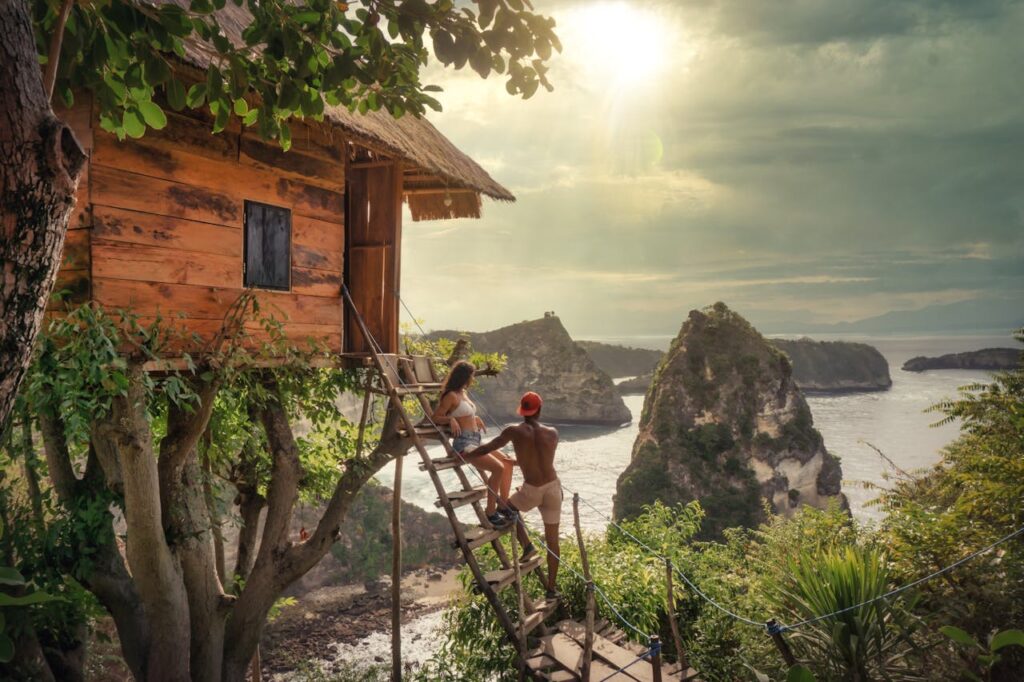As a traveler who has extensively explored Southeast Asian countries like The Philippines, Cambodia, Vietnam, and Singapore, I know firsthand the challenges that the hot and humid tropical climate can present to visitors. Whether you are a tourist seeking adventure or a business traveler on assignment, staying healthy and comfortable in the sweltering heat requires preparation and proactive measures.
In this comprehensive guide, I will share valuable insights and practical tips to help you navigate the tropical destinations of Southeast Asia while prioritizing your well-being.
Understanding Heat-Related Illnesses
Before delving into specific strategies, it is important to understand the potential heat-related illnesses that can arise in tropical climates.
Heat stroke, heat exhaustion, and dehydration are among the most common concerns, and recognizing their symptoms can be life-saving.
As always, refer to CDC’s travel guidelines on your tropical destination.
Heat Stroke
Heat stroke is a medical emergency characterized by a dangerously high body temperature (typically above 104°F or 40°C), accompanied by confusion, loss of consciousness, and potential organ failure if left untreated.
Symptoms may include dizziness, headache, rapid breathing, and hot, dry skin.
Heat Exhaustion
Heat exhaustion is a precursor to heat stroke and can manifest as heavy sweating, muscle cramps, nausea, and fatigue. If not addressed promptly, it can progress into the more severe heat stroke.
Dehydration
In the intense heat and humidity of tropical regions, dehydration is a constant threat.
Symptoms like dark-colored urine, dizziness, and dry mouth indicate that you are not replenishing fluids adequately.
Recognizing these conditions early and taking immediate action, such as moving to a cooler area, rehydrating, and seeking medical attention if necessary, can prevent serious complications.
Staying Hydrated
Maintaining proper hydration is arguably the most crucial aspect of staying healthy in the tropical heat. During my travels in Southeast Asia, I have learned the hard way that dehydration can sneak up quickly, leaving you feeling lethargic, irritable, and potentially putting your health at risk.
Safe Drinking Water Sources
Access to clean drinking water is a must, but it is not always readily available or safe to consume in some areas.
I recommend carrying a reusable water bottle and refilling it from trusted sources, such as bottled water, filtered water dispensers in hotels, or restaurant water that has been boiled or treated.
Avoid drinking tap water or untreated sources, as they may contain harmful bacteria or parasites.
Recognizing Signs Of Dehydration
Pay close attention to your body’s signals, such as dark yellow urine, dry mouth, and decreased urine output.
If you experience these signs, increase your fluid intake immediately. Carry electrolyte-rich drinks or snacks to replenish essential minerals lost through sweat.
Staying Hydrated During Activities
When participating in outdoor activities or exploring under the scorching sun, hydration becomes even more critical.
I always carry a refillable water bottle and make a conscious effort to drink regularly, even if I do not feel thirsty.
Setting reminders or using hydration tracking apps can be helpful for staying on top of your fluid intake.
Dressing For The Heat
Proper clothing can make a significant difference in your comfort level and ability to cope with the tropical heat. During my travels, I have learned to prioritize lightweight, breathable fabrics that wick away sweat and allow for optimal air circulation.
Lightweight And Breathable Materials
Natural fibers like cotton, linen, and bamboo are excellent choices for hot and humid climates. They allow your skin to breathe and help regulate body temperature more effectively than synthetic materials.
Opt for loose-fitting, lightweight clothing that doesn’t cling to your body or restrict airflow.
Sun Protection
While lightweight clothing is essential, it is also crucial to protect yourself from the intense tropical sun.
Look for lightweight, long-sleeved shirts and pants made from UV-protective fabrics or treated with sun-blocking agents. A wide-brimmed hat and sunglasses can also help shield your face and eyes from harmful UV rays.
Layering And Versatility
Southeast Asia’s tropical regions can experience temperature fluctuations throughout the day or between indoor and outdoor environments.
Layering lightweight pieces allows you to adjust your clothing as needed. Pack versatile items that can be mixed and matched, enabling you to adapt to changing conditions while staying comfortable.
Avoiding Insect-Borne Illnesses
Tropical destinations like Southeast Asia are known for their diverse array of insects, some of which can transmit diseases like dengue, malaria, and Zika. Taking preventive measures against insect-borne illnesses is crucial for maintaining your health during your travels.
Insect Repellents
Effective insect repellents are your first line of defense against mosquitoes and other disease-carrying insects.
Look for products containing DEET, picaridin, or other EPA-approved active ingredients. Apply repellent liberally to exposed skin and clothing, following the product instructions carefully.
Protective Clothing
In addition to repellents, wearing lightweight, long-sleeved shirts and pants can provide an extra barrier against insect bites.
Consider treating your clothing with permethrin, an insecticide that offers added protection against mosquitoes and other insects.
Vaccine Recommendations For Southeast Asia
Depending on your travel itinerary and specific destinations, you may need to obtain certain vaccinations or prophylactic medications.
Consult with a travel health professional or your doctor well in advance to discuss vaccine recommendations for Southeast Asia, including those for diseases like Japanese encephalitis, rabies, and typhoid fever.
Acclimatizing To The Tropical Climate
Even for seasoned travelers, adjusting to the intense heat and humidity of Southeast Asia can be a challenge. During my early trips to the region, I learned the importance of gradually acclimatizing to the tropical climate to avoid feeling overwhelmed or experiencing heat-related illnesses.
Gradual Adjustment
When you first arrive in a tropical destination, it is best to take it easy and allow your body time to adapt.
Avoid strenuous activities or prolonged sun exposure during the initial days, and gradually increase your activity level as you become more accustomed to the heat and humidity.
Rest And Recovery
Build in ample rest periods throughout the day, especially during the hottest hours.
Seek out air-conditioned spaces or shaded areas to cool down and rehydrate. This will help prevent heat exhaustion and allow you to enjoy your activities more comfortably.
Timing Outdoor Activities
If possible, plan outdoor activities or sightseeing for the cooler morning or evening hours when temperatures are more manageable.
The midday sun in tropical regions can be intense, and exerting yourself during peak heat can quickly lead to heat-related issues.
Seeking Medical Assistance
Despite your best efforts, there may be instances where you require professional medical attention during your travels in Southeast Asia. Being prepared and knowing how to access quality healthcare can make a significant difference in such situations.
Reputable Healthcare Facilities
Before your trip, research reputable hospitals or medical clinics in the areas you will be visiting.
International hospitals or facilities catering to expatriates and tourists may offer higher standards of care and have staff who speak English or other languages you are familiar with.
Navigating Language Barriers
If you encounter a language barrier when seeking medical assistance, consider using translation apps, phrase books, or enlisting the help of a local guide or hotel staff.
Many healthcare facilities in Southeast Asia have multilingual staff or access to interpreters to ensure effective communication.
Travel Insurance And Emergency Contacts
Investing in comprehensive travel insurance can provide peace of mind and financial protection in case you need medical evacuation or treatment for serious injuries or illnesses.
Keep emergency contact information for your insurance provider, embassy, and trusted contacts readily available.
Personal Anecdotes And Lessons Learned
Throughout my travels in Southeast Asia, I have encountered various challenges related to the tropical climate and learned valuable lessons along the way.
One experience that stands out vividly is a hiking excursion in Cambodia. Well, it is not really a hiking excursion – more like climbing the stairs of the temples of Ankor Wat. Those are pretty steep!
I underestimated the intense humidity and relentless sun. Within a couple of hours, I found myself severely dehydrated, with muscle cramps and a pounding headache.
Our local guide recognized the signs and insisted we take a break inside one of the temples, where a kind monk gave me water to rehydrate.
That experience taught me the importance of respecting the tropical environment and not pushing myself beyond my limits.
I now make it a priority to carry ample water, take frequent breaks, and listen to my body’s signals when exploring hot and humid regions.
Another memorable lesson came during a city tour in The Philippines, where I neglected to apply insect repellent.
By the end of the day, I was covered in mosquito bites, and a few days later, I developed a mild case of dengue fever.
While it was not a severe illness, it was a valuable reminder of the importance of taking preventive measures against insect-borne diseases in tropical destinations.
These personal experiences have shaped my approach to traveling in Southeast Asia, and I hope sharing them will help you better prepare and stay vigilant about your health and well-being during your adventures in the region.
Dealing with the heat and tropical climate in Southeast Asia requires a proactive mindset, proper preparation, and a willingness to adapt and listen to your body.
By following the tips and strategies outlined in this guide, you can enjoy the rich cultural experiences and natural wonders of the region while prioritizing your health and safety.








